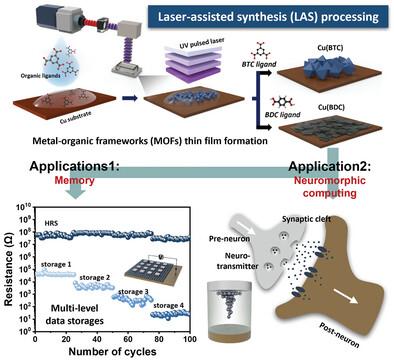当前位置:
X-MOL 学术
›
Adv. Funct. Mater.
›
论文详情
Our official English website, www.x-mol.net, welcomes your feedback! (Note: you will need to create a separate account there.)
Lasing‐Assisted Synthesis of Metal–Organic Frameworks (MOFs) and Its Application to Memory and Neuromorphic Devices
Advanced Functional Materials ( IF 18.5 ) Pub Date : 2024-06-29 , DOI: 10.1002/adfm.202406088 Seung Woo Han 1 , Chang Taek Lee 1 , Young‐Woong Song 1 , Yeowon Yoon 1 , Jang‐Yeon Kwon 1 , Lianqiao Yang 2 , Moo Whan Shin 1
Advanced Functional Materials ( IF 18.5 ) Pub Date : 2024-06-29 , DOI: 10.1002/adfm.202406088 Seung Woo Han 1 , Chang Taek Lee 1 , Young‐Woong Song 1 , Yeowon Yoon 1 , Jang‐Yeon Kwon 1 , Lianqiao Yang 2 , Moo Whan Shin 1
Affiliation

|
Recently, metal–organic frameworks (MOFs) have gained attention in the field of electronics owing to their capability to tune their electrical characteristics. However, conventional methods for synthesizing MOFs pose challenges for their integration into electronic devices because of their long synthesis times and complex transfer steps. In this study, for the first time, lasing‐assisted synthesis (LAS) is used to rapidly and directly synthesize MOFs. These are applied to resistive random access memory (RRAM) devices. Using the LAS method, Cu(BDC) and Cu(BTC) are synthesized in a remarkably short time (≈5 min) and formed directly on metal substrates as thin films. This simplified their integration into RRAMs. The Cu(BDC)‐ and Cu(BTC)‐based RRAMs are evaluated for their potential in memory and neuromorphic applications. Both devices demonstrated nonvolatile memory capabilities with a remarkable data retention time of 104 s and long‐term plasticity (LTP) in response to voltage stimuli. However, the suitability of each device for a specific application varies depending on the type of MOFs used. The Cu(BTC)‐based RRAM is more suitable for memory applications because of its higher on/off ratio, longer endurance, and more data storage capacity. Conversely, Cu(BDC)‐based RRAM is highly effective in neural network simulation, achieving higher classification accuracy.
中文翻译:

金属有机框架(MOF)的激光辅助合成及其在记忆和神经形态设备中的应用
最近,金属有机框架(MOF)由于其具有调节电特性的能力而在电子领域受到关注。然而,传统的 MOF 合成方法由于合成时间长且转移步骤复杂,对其集成到电子器件中提出了挑战。在这项研究中,首次使用激光辅助合成(LAS)来快速直接合成MOF。这些适用于电阻式随机存取存储器 (RRAM) 器件。使用 LAS 方法,Cu(BDC) 和 Cu(BTC) 在非常短的时间内(约 5 分钟)合成,并直接在金属基底上形成薄膜。这简化了它们与 RRAM 的集成。对基于 Cu(BDC) 和 Cu(BTC) 的 RRAM 在内存和神经形态应用中的潜力进行了评估。这两款器件都展示了非易失性存储功能,具有 104 秒的出色数据保留时间和响应电压刺激的长期可塑性 (LTP)。然而,每种器件对特定应用的适用性取决于所使用的 MOF 类型。基于Cu(BTC)的RRAM具有更高的开/关比、更长的耐用性和更大的数据存储容量,更适合存储器应用。相反,基于 Cu(BDC) 的 RRAM 在神经网络模拟中非常有效,可以实现更高的分类精度。
更新日期:2024-06-29
中文翻译:

金属有机框架(MOF)的激光辅助合成及其在记忆和神经形态设备中的应用
最近,金属有机框架(MOF)由于其具有调节电特性的能力而在电子领域受到关注。然而,传统的 MOF 合成方法由于合成时间长且转移步骤复杂,对其集成到电子器件中提出了挑战。在这项研究中,首次使用激光辅助合成(LAS)来快速直接合成MOF。这些适用于电阻式随机存取存储器 (RRAM) 器件。使用 LAS 方法,Cu(BDC) 和 Cu(BTC) 在非常短的时间内(约 5 分钟)合成,并直接在金属基底上形成薄膜。这简化了它们与 RRAM 的集成。对基于 Cu(BDC) 和 Cu(BTC) 的 RRAM 在内存和神经形态应用中的潜力进行了评估。这两款器件都展示了非易失性存储功能,具有 104 秒的出色数据保留时间和响应电压刺激的长期可塑性 (LTP)。然而,每种器件对特定应用的适用性取决于所使用的 MOF 类型。基于Cu(BTC)的RRAM具有更高的开/关比、更长的耐用性和更大的数据存储容量,更适合存储器应用。相反,基于 Cu(BDC) 的 RRAM 在神经网络模拟中非常有效,可以实现更高的分类精度。






































 京公网安备 11010802027423号
京公网安备 11010802027423号